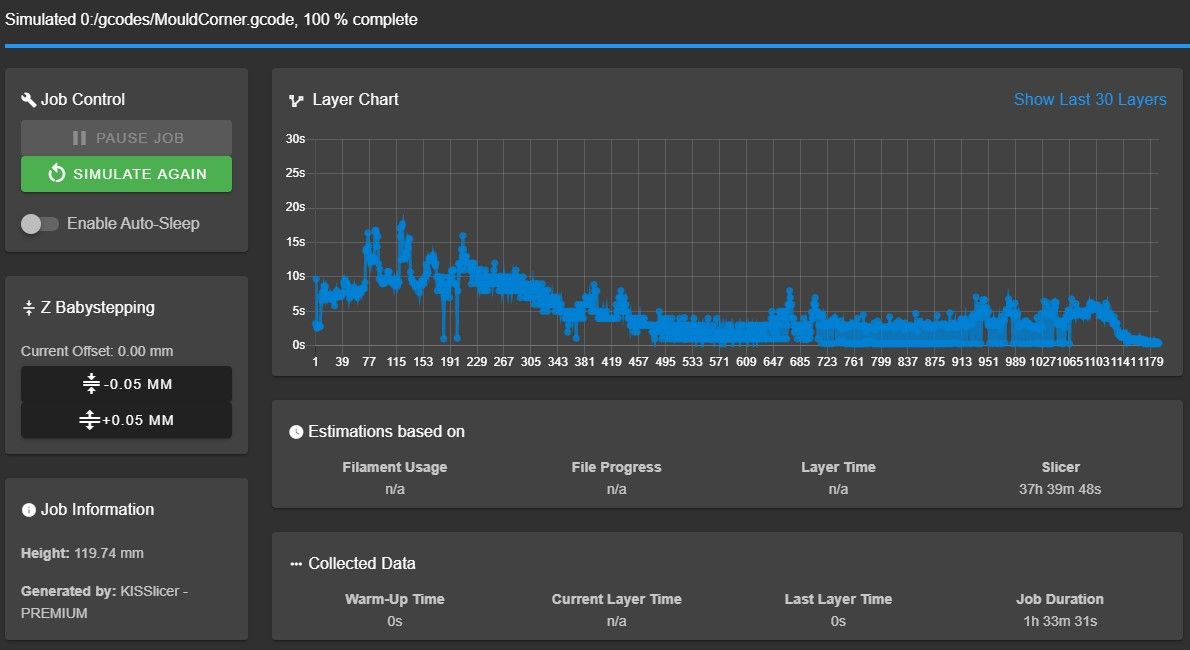We have arrived at the moment of truth.
Friday I assembled the molds with, as you can see, the white pieces in there to make bolt holes and a piece of rebar in the center. Saturday I mixed up another 3 bags of concrete mix and did the pour. Then finally on Tuesday, I demolded the slabs and attached them to the printer. Before I go over the results, I'll share some more of my experiences and remarks.
Removing the wood mold pieces went very very easy just like last time. The white inserts for molding the bolt holes were not. From the 40 spread over the two slabs, just four came out with gentle percussive action. I did have a 1,5° taper angle on the pieces, but I ended up needing to use a drill to get rid of most of the plastic. The last cleanup was done using a hot air station at 200°C. The holes are not perfectly smooth around the edges, but no major issues.
Last time I noticed that the sides touching the mold wood were quite dusty and remained quite dusty no matter what I did. I did a quick google and assumed bad mixing was to blame for that. On the two new slabs I notice the same however, yet that could be due to me using the same mixing ratios. But actually I now believe it is due to the wood absorbing moisture from the concrete while it is still wet, thus effectively causing localized bad mixing. I figured this as I poured the excess concrete in a plastic bucket and after drying is was completely dust free. The wood absorbing moisture also explains why the top surface did not show the same issue.
I decided to add a piece of rebar in the center to give some added strength as the piece is quite thin compared to its length and did not want it cracking in half while working with it. The picture below shows how I suspended the rebar with some metal wire between the printed pieces. After demolding I noticed something interesting. In both slabs I can feel something moving quite distinctly when I jiggle a little with the slab upright. It really feels like the rebars are loosey goosey in there  Don't ask my why, and I guess at this point it doesn't really matter that much either.
Don't ask my why, and I guess at this point it doesn't really matter that much either.
While playing with the first slab, I became clear that it did not sit perfectly straight against the tower. I got a piece of ~3mm rubber matting from a local home improvement store that sold it by the meter. I cut six pieces sized and holed correctly for the slab so I could double up on the thickness if needed. In the end I did end up just using one piece per tower, but oh well.
Now it is finally time for the moment of truth, attaching the slabs to the towers. At a little of 30kg a piece it was not trivial but I managed to get them one there. Some bolt holes are left open as one or two holes are badly located and do not line up well enough, or the t-nut fell down while playing with the bolt and I did not feel like removing the slab to put a t-nut back  . Once I attached the first slab and even the second I did some test moves and was not really impressed with what I heard. But the third was the charm I guess, definitely an improvement. I can no longer feel any vibrations with my hands on the towers.
. Once I attached the first slab and even the second I did some test moves and was not really impressed with what I heard. But the third was the charm I guess, definitely an improvement. I can no longer feel any vibrations with my hands on the towers.
I must nuance the results a bit sadly. While the difference is certainly there and is quite noticeable, it's not perfect and not really acceptable even. I went from being able to hear the printer form all areas of the house to only audible in the next room. To combat the last noise I have some proper nema 23 dampers on order and I am most likely going to construct some sort of enclosure for the entire printer, that I line with sound dampening material.
Congrats to the people that made it this far down the wall of text, enjoy the pictures and drop an upvote if you think these longer post as worth the time  Many thanks to all that pitched in with ideas and suggestions.
Many thanks to all that pitched in with ideas and suggestions.




Just for the curious among us, this ended up costing my about €165, of which almost half went to the M8 t-nuts and the blue pigment.


 The first two datasets were started when I notices warning popping up in dwc, so they are probabily missing the first pieces of vital information. The 3rd set contains everything from start to finish.
The first two datasets were started when I notices warning popping up in dwc, so they are probabily missing the first pieces of vital information. The 3rd set contains everything from start to finish.



















